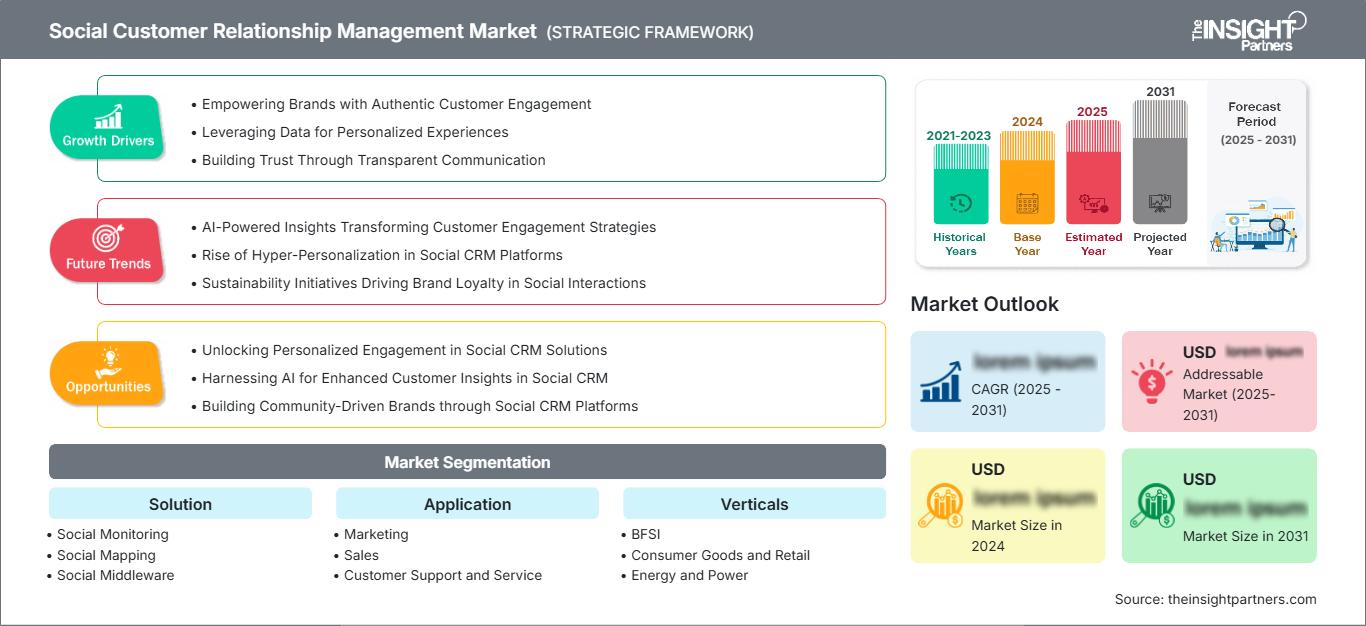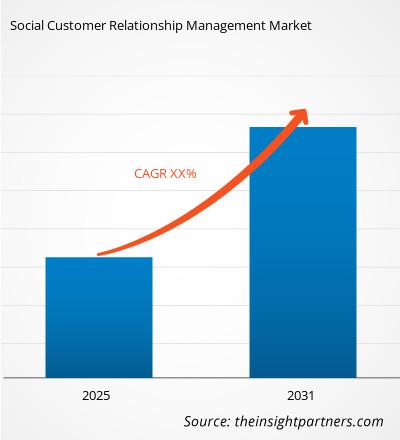Si prevede che il mercato del Social Customer Relationship Management registrerà una crescita costante dal 2026 al 2034, con una valutazione prevista in crescita rispetto al valore di riferimento del 2025 e in continua espansione fino alla fine del periodo di previsione. Questa tendenza riflette una prospettiva di mercato favorevole, guidata dall'evoluzione dei requisiti del settore e dai continui progressi tecnologici.
Il rapporto è suddiviso in base alle soluzioni (monitoraggio social, mappatura social, middleware social, gestione social, misurazione social) e analizza ulteriormente il mercato in base all'applicazione (marketing, vendite, assistenza clienti e servizi). Esamina inoltre il mercato per settori verticali (BFSI, beni di consumo e vendita al dettaglio, energia ed energia, sanità, petrolio e gas, telecomunicazioni e IT, automotive, pubblica amministrazione, trasporti e logistica) e per dimensione dell'organizzazione industriale (piccole e medie imprese, grandi imprese). Per ciascuno di questi segmenti chiave viene fornita una ripartizione completa a livello globale, regionale e nazionale. Il rapporto include le dimensioni del mercato e le previsioni per tutti i segmenti, presentando i valori in dollari statunitensi. Fornisce inoltre statistiche chiave sullo stato attuale del mercato dei principali attori, insieme ad approfondimenti sulle tendenze prevalenti e sulle opportunità emergenti.
Scopo del rapporto
Il rapporto "Social Customer Relationship Management Market" di The Insight Partners mira a descrivere il panorama attuale e la crescita futura, i principali fattori trainanti, le sfide e le opportunità. Ciò fornirà spunti a vari stakeholder aziendali, come:
- Fornitori/Produttori di tecnologia: per comprendere le dinamiche di mercato in evoluzione e conoscere le potenziali opportunità di crescita, consentendo loro di prendere decisioni strategiche informate.
- Investitori: per condurre un'analisi completa delle tendenze in merito al tasso di crescita del mercato, alle proiezioni finanziarie di mercato e alle opportunità esistenti lungo la catena del valore.
- Enti di regolamentazione: per regolamentare le politiche e le attività di controllo sul mercato con l'obiettivo di ridurre al minimo gli abusi, preservare la fiducia degli investitori e sostenere l'integrità e la stabilità del mercato.
Soluzione di segmentazione del mercato per la gestione delle relazioni con i clienti sui social media
- Monitoraggio social
- Mappatura social
- Middleware social
- Gestione social
- Misurazione social
Applicazione
- Marketing
- Vendite
- Assistenza clienti e servizio
Settori verticali
- BFSI
- Beni di consumo e vendita al dettaglio
- Energia e potenza
- Sanità
- Petrolio e gas
- Telecomunicazioni e IT
- Automotive
- Governo
- Trasporti e logistica
Dimensioni dell'organizzazione
- Piccole e medie imprese
- Grandi imprese
Potrai personalizzare gratuitamente qualsiasi rapporto, comprese parti di questo rapporto, o analisi a livello di paese, pacchetto dati Excel, oltre a usufruire di grandi offerte e sconti per start-up e università
Mercato della gestione delle relazioni con i clienti sui social media: Approfondimenti strategici

-
Ottieni le principali tendenze chiave del mercato di questo rapporto.Questo campione GRATUITO includerà l'analisi dei dati, che vanno dalle tendenze di mercato alle stime e alle previsioni.
Fattori di crescita del mercato della gestione delle relazioni con i clienti sui social media
- Fornire ai marchi un coinvolgimento autentico dei clienti
- Sfruttare i dati per esperienze personalizzate
- Creare fiducia attraverso una comunicazione trasparente
Tendenze future del mercato della gestione delle relazioni con i clienti sui social media
- Informazioni basate sull'intelligenza artificiale che trasformano le strategie di coinvolgimento dei clienti
- Ascesa dell'iper-personalizzazione nelle piattaforme CRM sui social media
- Iniziative di sostenibilità che promuovono la fedeltà al marchio nelle interazioni social
Opportunità di mercato della gestione delle relazioni con i clienti sui social media
- Sbloccare il coinvolgimento personalizzato nelle soluzioni CRM sui social media
- Sfruttare l'intelligenza artificiale per ottenere informazioni migliori sui clienti nel CRM sui social media
- Creare marchi guidati dalla comunità tramite il CRM sui social media Piattaforme
Mercato della gestione delle relazioni con i clienti sui social media
Le tendenze regionali e i fattori che influenzano il mercato del Social Customer Relationship Management durante il periodo di previsione sono stati ampiamente spiegati dagli analisti di The Insight Partners. Questa sezione illustra anche i segmenti e la geografia del mercato della gestione delle malattie del ritmo cardiaco in Nord America, Europa, Asia-Pacifico, Medio Oriente e Africa, America meridionale e centrale.
Mercato della gestione delle relazioni con i clienti sui social media Report Scope
| Attributo del rapporto | Dettagli |
|---|---|
| Dimensioni del mercato in 2025 | US$ XX Million |
| Dimensioni del mercato per 2034 | US$ XX Million |
| CAGR globale (2026 - 2034) | XX% |
| Dati storici | 2021-2024 |
| Periodo di previsione | 2026-2034 |
| Segmenti coperti |
By Soluzione
|
| Regioni e paesi coperti |
Nord America
|
| Leader di mercato e profili aziendali chiave |
|
Densità degli operatori del mercato della gestione delle relazioni con i clienti sui social media: comprendere il suo impatto sulle dinamiche aziendali
Il mercato del Social Customer Relationship Management è in rapida crescita, trainato dalla crescente domanda degli utenti finali, dovuta a fattori quali l'evoluzione delle preferenze dei consumatori, i progressi tecnologici e una maggiore consapevolezza dei vantaggi del prodotto. Con l'aumento della domanda, le aziende stanno ampliando la propria offerta, innovando per soddisfare le esigenze dei consumatori e sfruttando le tendenze emergenti, alimentando ulteriormente la crescita del mercato.

- Ottieni il Mercato della gestione delle relazioni con i clienti sui social media Panoramica dei principali attori chiave
Punti di forza
- Copertura completa: il rapporto analizza in modo esaustivo prodotti, servizi, tipologie e utenti finali del mercato della gestione delle relazioni con i clienti sui social network, offrendo una panoramica olistica.
- Analisi degli esperti: il rapporto è redatto sulla base della conoscenza approfondita di esperti e analisti del settore.
- Informazioni aggiornate: il rapporto garantisce la pertinenza aziendale grazie alla copertura di informazioni e tendenze dei dati recenti.
- Opzioni di personalizzazione: questo rapporto può essere personalizzato per soddisfare le esigenze specifiche del cliente e adattarsi in modo appropriato alle strategie aziendali.
Il rapporto di ricerca sul mercato della gestione delle relazioni con i clienti sui social network può quindi contribuire a guidare il percorso di decodificazione e comprensione dello scenario del settore e delle prospettive di crescita. Sebbene possano esserci alcune valide preoccupazioni, i vantaggi complessivi di questo rapporto tendono a superare gli svantaggi.
- Analisi storica (2 anni), anno base, previsione (7 anni) con CAGR
- Analisi PEST e SWOT
- Valore/volume delle dimensioni del mercato - Globale, Regionale, Nazionale
- Industria e panorama competitivo
- Set di dati Excel
Report recenti
Rapporti correlati
Testimonianze
Motivo dell'acquisto
- Processo decisionale informato
- Comprensione delle dinamiche di mercato
- Analisi competitiva
- Analisi dei clienti
- Previsioni di mercato
- Mitigazione del rischio
- Pianificazione strategica
- Giustificazione degli investimenti
- Identificazione dei mercati emergenti
- Miglioramento delle strategie di marketing
- Aumento dell'efficienza operativa
- Allineamento alle tendenze normative






















 Ottieni un campione gratuito per - Mercato della gestione delle relazioni con i clienti sui social media
Ottieni un campione gratuito per - Mercato della gestione delle relazioni con i clienti sui social media